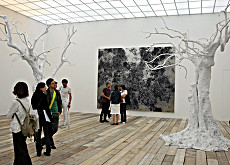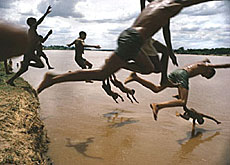Looking back with a photographer’s world view

A young child proudly flexes his biceps, police inspect a bloody corpse, Romanians take cover from snipers and an adoring crowd envelops its hero Martin Luther King.
These are just a small selection of the brutally honest, but deeply touching, poetic works of Magnum photographer Leonard Freed currently on display at Lausanne’s Musée de l’Elysée in his first major retrospective – “Worldview”.
Leonard Freed, who died last year aged 77, was a quiet, introspective man who preferred the language of black-and-white photography to prose to document the daily struggles of ordinary people over the past 50 years – from Hassidic Jewish communities to protesting black Americans.
“Leonard Freed was a very independent person,” associate curator Nathalie Herschdorfer told swissinfo. “He had a strong interest in people and wanted to show them in a positive light.”
Freed might not be one of the best-known Magnum photographers, like Robert Capa or Henri Cartier-Bresson, but over the years thousands of his photographs appeared in the international press. He also published numerous books and exhibited widely.
The care and attention given to his first major retrospective can be seen in the quality of the 225 black-and-white photographs that capture the essence of his lifetime work.
Freed and his wife, together with the Lausanne team, took over five years to go through his archive of over one million negatives to put together Worldview, which covers some of the major world events over the past 50 years, including the American Civil Rights Movement and the Israeli-Palestinian conflict.
Marathon runner
Although often labelled a press photographer or photojournalist, Freed was more a marathon runner of the photographic world, thoughtfully building his subjects over time rather than chasing money and fame from more newsworthy events.
Among the more iconic images in the exhibition is one of Martin Luther King, part of a series documenting black Americans in the 1960s.
“What interested him is not Martin Luther King himself, but rather the group of people who are touching and looking at the hand of their hero,” explained Herschdorfer.
As a US citizen, segregation and discrimination against black Americans annoyed Freed intensely, and he wanted to better understand it: “I wanted to see their differences, to see them as individuals and not as a mass.”
He was born into a working-class Jewish family of eastern European extraction in New York. As soon as he finished his studies, he took off for two years, hitchhiking through Europe and North Africa, where he started taking photographs.
In 1956 he settled in the Netherlands from where he worked as a freelance photographer, selling his photos to various magazines.
Freed had a humanist view of the world that was based on a deep concern for other human beings and the social structures they build and tear down.
This philosophical look on life would have a profound influence on his work and lead to his name becoming synonymous with that of the “concerned photographer”.
Understanding the world
For Freed, landscapes and cityscapes were the frames to present social interaction or individual human behaviour in a positive light. Photography was also his tool for better understanding the world, first for himself, and then for others.
He took photos of Hassidic Jews not because he was Jewish but because he might have been one of them had history dealt his Russian family another hand.
A large part of the exhibition focuses on his work on the New York police in the 1960s and 1970s. He made a decade-long fly-on-the-wall study of the police, embedding himself amongst them, following then on the beat and visiting them in their homes because he felt they were being persecuted by society as scapegoats for its own failures.
After gaining fame and recognition in the 1960s, Freed once commented: “Suddenly, I feel as if I belong to a tradition. To see life, see the world, be witness to great events, peer into the faces of the poor, the mad, to understand the shadows of the jungle, hidden things, to see, to rejoice in seeing, to be spiritually enriched.”
swissinfo, Simon Bradley in Lausanne
Leonard Freed was born in 1929 in Brooklyn, New York, to a working-class Jewish family from eastern Europe.
Freed, who first wanted to become a painter, began taking photographs while backpacking around Europe in 1952.
In 1956 he moved to the Netherlands. He travelled widely, photographing blacks in America, events in Israel, the Yom Kippur war and the New York City police department, among others. In 1970 he moved from the Netherlands to New York, joining the Magnum Photos agency, with whom he had worked since 1956.
Many of Freed’s photographs have been published in the international press, including Life, Paris Match, Der Spiegel, Der Stern, Sunday Times, GEO, L’Express, Libération and Fortune. He also published around ten books which present his thematic work, including: Black in White America, La danse des fidèles and Police Work.
Freed died in Garrison, New York on November 29, 2006
The Leonard Freed retrospective at the Elysée museum in Lausanne runs until September 2, 2007.
The museum is open from Tuesday to Sunday from 11am to 7pm (closed Mondays).
The exhibition was put together with the help of Leonard and Brigitte Freed and produced together with Magnum Photos, Paris and the Fotomuseum, The Hague.

In compliance with the JTI standards
More: SWI swissinfo.ch certified by the Journalism Trust Initiative













You can find an overview of ongoing debates with our journalists here . Please join us!
If you want to start a conversation about a topic raised in this article or want to report factual errors, email us at english@swissinfo.ch.